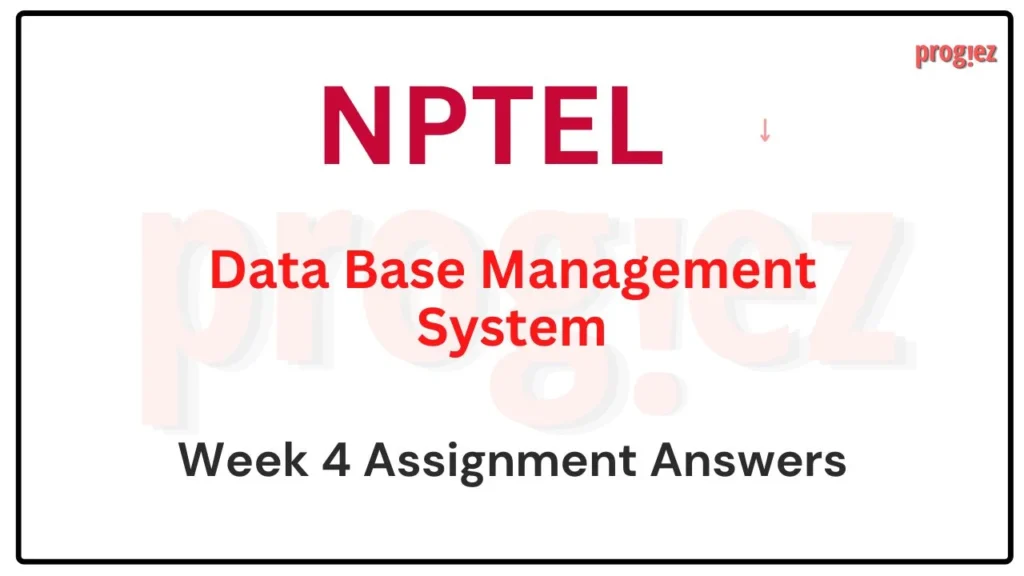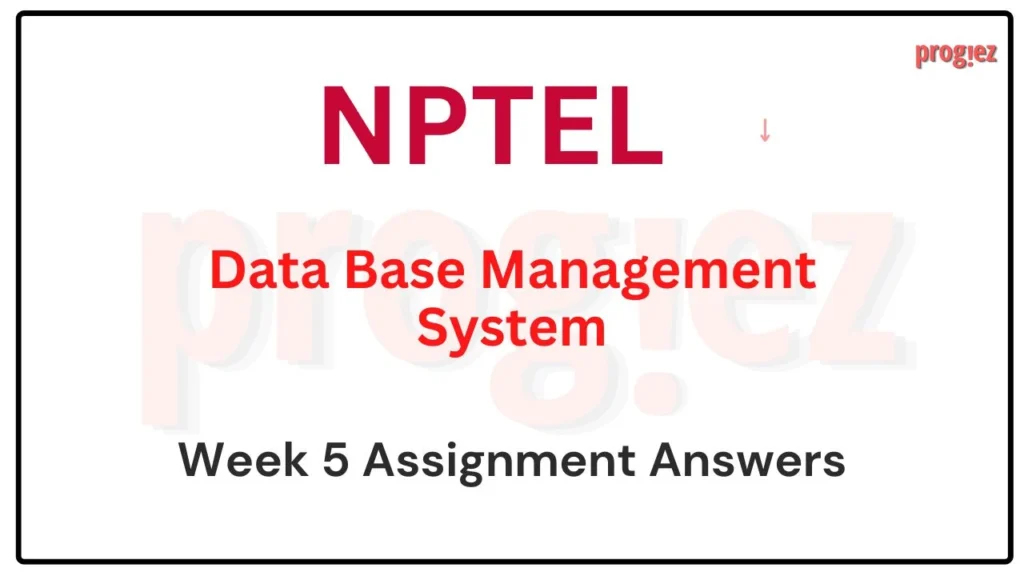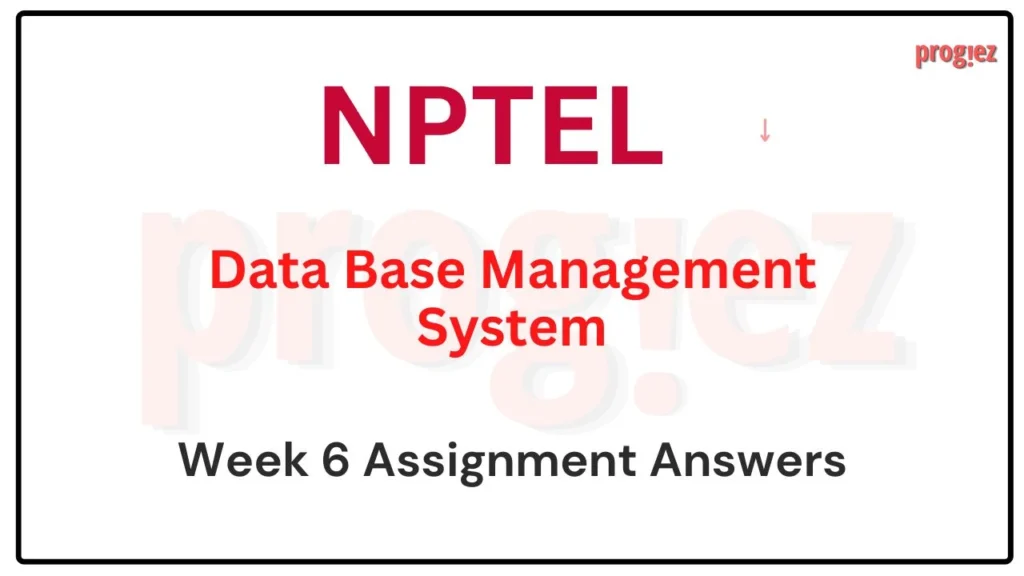Nptel Database Management System Assignment 7 Answers
Are you looking for the Nptel Database Management System Assignment 7 Answers? You’ve come to the right place! Our detailed and accurate solutions are designed to assist you in mastering the concepts of DBMS, including SQL queries, database design, normalization, and more.
Course Link: Click Here
Table of Contents

Nptel Database Management System Assignment 7 Answers (July-Dec 2024)
Q1. Consider the following schedule S$ of transactions Tj and Ty.
The read operation on data item A is denoted by read(A) and the write operation on data
item A is denoted by write(A).
Answer: a) In primary index, index entries can be stored in unsorted order of the search key value.
c) A clustered index is built by default on any sorted valued columns.
Q2.Which of the splitting rule is not correct in respect of 2-3-4 Tree?
Answer: A)
For answers or latest updates join our telegram channel: Click here to join
These are Nptel Database Management System Assignment 7 Answers
Q3.Consider a system that uses B+ tree for indexing its records. Calculate the order of a non-leaf
node, if the block size is 2 kilobytes, size of the search key field is 10 bytes, and the block
pointer size is 18 bytes?
a) 44
b) 73
c) 113
d) 204
Answer: b) 73
Q4. A hash table contains 10 (indices 0 to 9) buckets and uses linear probing to resolve collisions.
The key values are integers and the hash function used is (key % 10). Given the follow-
ing input (543, 432, 741, 330, 471, 351, 170, 245), which of the following statement(s)
is/are true?
a) 245 is stored in bucket 5.
b) 741, 471, 351 are stored in buckets 1, 4, and 5.
c) 432, 543 are stored in buckets 2 and 3.
d) 170 is stored in bucket 4.
Answer: b) 741, 471, 351 are stored in buckets 1, 4, and 5.
c) 432, 543 are stored in buckets 2 and 3.
For answers or latest updates join our telegram channel: Click here to join
These are Nptel Database Management System Assignment 7 Answers
Q5.Suppose, there is a DBMS file with size 16 kilobytes. Calculate the size of the index table, if
the size of one record is 64 bytes long which includes 10 bytes key field assuming the system
uses primary indexing and the record pointer is 48-bit long?
a) 1 kilobyte
b) 2 kilobytes
c) 3 kilobytes
d) 4 kilobytes
Answer: d) 4 kilobytes
Q6.Consider the following table Patient. If we want to create an index on PatID column, which type of indexing will be preferred?
a) Sparse index
b) Dense index
c) Secondary index
d) Non-clustering index
Answer:b) Dense index
For answers or latest updates join our telegram channel: Click here to join
Q7.There is a 2-3-4 Tree as follows:
For searching 34, how many comparisons will be required ?
a) 11
b) 7
c) 4
d) 3
Answer: d) 3
Q8.See the following B+ tree. Find the minimum number of nodes (including the root node) that
must be fetched in order to satisfy the following query:
“Find all the records greater than 5 and less than 17”
a) 4
b) 5
c) 6
d) 7
Answer: a) 4
For answers or latest updates join our telegram channel: Click here to join
Q9.Consider a shop maintained a relation Order (Order No, ItemID, Quantity) for storing or-
der information. We have created a bitmap index on Order table and the size of the index
file is 512 bytes for 256 number of rows. How many different types of items are availble in the
shop assuming ItemID as the index column?
a) 16
b) 8
c) 4
d) 2
Answer: a) 16
Q10.Consider the following OrderTable:
For the Order Table table, assume that there are 10 salesmen, and each salesman is associated
with a minimum of 500 orders. Suppose OrderTable is commonly queried as:
SELECT * FROM OrderTable WHERE Orderno = ‘XXXX’ AND salesman.id = Y;
For speeding up the execution of queries, it is decided to create an index on the table. Which
of the following query will create such an index?
a) CREATE INDEX ind Order ON Order(Order.no);
b) CREATE INDEX ind Order ON Order(salesman id);
c) CREATE INDEX ind Order ON Order(Order.no, salesman.id);
d) CREATE MULTI INDEX ind Order ON Order(Order_no, salesman id);
Answer: c) CREATE INDEX ind Order ON Order(Order.no, salesman.id);
For answers or latest updates join our telegram channel: Click here to join
All Weeks of Database Management System: Click here
For answers to additional Nptel courses, please refer to this link: Check here
For answers or latest updates join our telegram channel: Click here to join
All Weeks of Database Management System: Click here
For answers to additional Nptel courses, please refer to this link: Check here
Nptel Database Management System Assignment 7 Answers (JAN-APR 2024)
Course Name: Data Base Management System
Course Link: Click Here
For answers or latest updates join our telegram channel: Click here to join
These are Data Base Management System Week 7 Assignment Answers
Q1. Consider the following schedule S involving five transactions T1, T2, T3, T4 and T5:
R(X) denotes read operation on data item X by transaction Ti.
W(X) denotes write operation on data item X by transaction Ti.
Choose the correct option for the above transaction schedule.
a) The schedule is both view and conflict serializable schedule.
b) The schedule is neither conflict serializable nor view serializable schedule.
c) The schedule is only view serializable schedule.
d) The schedule is only conflict serializable schedule.
Answer: a) The schedule is both view and conflict serializable schedule.
Q2. Consider the following schedule S involving five transactions T1, T2, T3, T4 and T5:
R(X) denotes read operation on data item X by transaction Ti.
W(X) denotes write operation on data item X by transaction Ti.
Identify the possible number of conflict serializable schedules of the above schedule S.
a) 1
b) 2
c) 3
d) 4
Answer: c) 3
For answers or latest updates join our telegram channel: Click here to join
These are Data Base Management System Week 7 Assignment Answers
Q3. Consider the following schedule S involving four transactions T1, T2, T3, and T4.
R(X) denotes read operation on data item X by transaction Ti.
W(Y) denotes write operation on data item Y by transaction Ti.
Identify the correct option(s) that represent the order of execution of all transactions of the above schedule S.
a) T1→T2→T3→T4
b) T3→T4→T1→T2
c) T4→T1→T3→T2
d) T3→T2→T1→T4
Answer: b) T3→T4→T1→T2
Q4. Suppose in a database, there are four transactions T1, T2, T3 and T4. Transaction Ta is waiting for transactions T3 and T₁, transaction T₁ is waiting for transaction T3, and transaction T3 is waiting for transaction T₁ to release a data item.
Identify the correct wait-for graph for the above scenario.
a)
b)
c)
d)
Answer: b)
For answers or latest updates join our telegram channel: Click here to join
These are Data Base Management System Week 7 Assignment Answers
Q5. Consider the following schedule S of transactions T1 and T2. The read operation on data item A is denoted by read (A) and the write operation on data item A is denoted by write(A).
Which of the following is TRUE about the schedule S?
a) S is not serializable either as T1, T2 or T2, T1.
b) S is serializable both as T1, T2 and T2, T1.
c) S is serializable only as T1, T2.
d) S is serializable only as T2, T1.
Answer: c) S is serializable only as T1, T2.
For answers or latest updates join our telegram channel: Click here to join
These are Data Base Management System Week 7 Assignment Answers
Q6. Identify the correct statement(s) about the lock compatibility matrix given below, where S denotes a shared mode lock and X denotes an exclusive mode lock.
a) If a transaction holds a S lock on a data item, other transaction will not be allowed to obtain a S lock on the same data item.
b) If a transaction holds a S lock on a data item, other transaction will not be allowed to obtain a X lock on the same data item.
c) If a transaction holds an X lock on a data item, other transactions can not be allowed to obtain a S lock on the same data item.
d) If a transaction holds an X lock on an item, other transactions can be allowed to obtain a S lock on the same data item.
Answer: b, c
For answers or latest updates join our telegram channel: Click here to join
These are Data Base Management System Week 7 Assignment Answers
Q7. Suppose in a database, there are three transactions T1, T2 and T3 with timestamps 15, 18, and 19 respectively. T2 is holding some data items which T1, T3 are requesting to acquire. Which of the following statement(s) is (are) correct in respect of Wait-Die Deadlock Preven- tion scheme?
a) Transaction T1 will wait for T2 to release the data item.
b) Transaction T3 will wait for T2 to release the data item.
c) Transaction T1 will be rollback.
d) Transaction T3 will be rollback.
Answer: a), d)
For answers or latest updates join our telegram channel: Click here to join
These are Data Base Management System Week 7 Assignment Answers
Q8. Consider two transactions given below where lock-X(A) denotes T₁ has obtained an Exclusive- mode lock on data item A and lock-S(A) denotes T; has obtained a Shared-mode lock on data item A. read(A) denotes read operation on data item A by the transaction Ti. write(A) denotes write operation on data item A by the transaction T.
Which of the following statement(s) is/are true?
a) T₁ follows the rigorous two-phase locking protocol only, but T₂ follows the strict two-phase locking protocol.
b) T₁ follows the rigorous two-phase locking protocol only, but Ta follows the two-phase locking protocol only.
c) Both T₁ and Ta follow the rigorous two-phase locking protocol.
d) Both T₁ and T₂ do not follow the rigorous two-phase locking protocol.
Answer: b) T₁ follows the rigorous two-phase locking protocol only, but Ta follows the two-phase locking protocol only.
For answers or latest updates join our telegram channel: Click here to join
These are Data Base Management System Week 7 Assignment Answers
Q9. Consider two schedules S₁ and S₂ as follows, where S denotes a shared mode lock and X denotes an exclusive mode lock.
Identify the correct statement from the following which relates to whether the schedules are deadlock free. Please note that if any schedule suffers from deadlock, some operations of the transactions in that schedule may not be executed.
a) Both S₁ and S₂ will suffer from deadlock.
b) S₁ will suffer from deadlock, S₂ will not suffer from deadlock.
c) S₁ will not suffer from deadlock, S₂ will suffer from deadlock.
d) Neither S₁ nor S₂ will suffer from deadlock.
Answer: d) Neither S₁ nor S₂ will suffer from deadlock.
For answers or latest updates join our telegram channel: Click here to join
These are Data Base Management System Week 7 Assignment Answers
Q10. Consider the following two schedules S1 and S2.
R(X) denotes read operation on data item X by Transaction Ti.
W(X) denotes write operation on data item X by Transaction Ti.
Which of the following statement(s) is/are true for the above two schedules S1 and S2?
a) Both schedules S1 and S2 are Recoverable Schedules.
b) Both schedules S1 and S2 are Cascadeless Schedules.
c) The schedule S1 is Cascadeless Schedule, the schedule S2 is Recoverable Schedule.
d) The schedule S1 is not a Recoverable Schedule, the schedule S2 is Cascadeless Schedule.
Answer: a), c)
For answers or latest updates join our telegram channel: Click here to join
These are Data Base Management System Week 7 Assignment Answers









